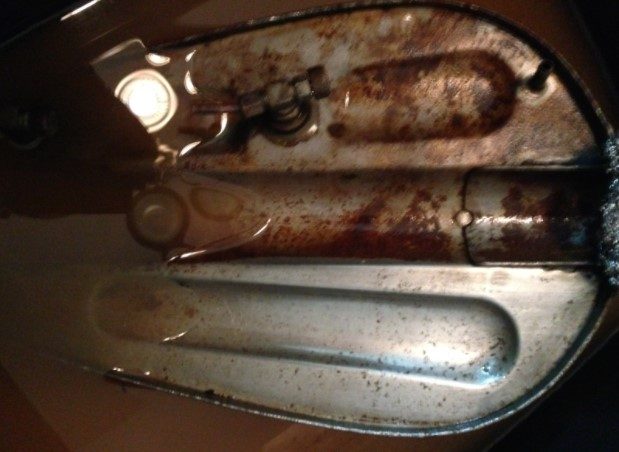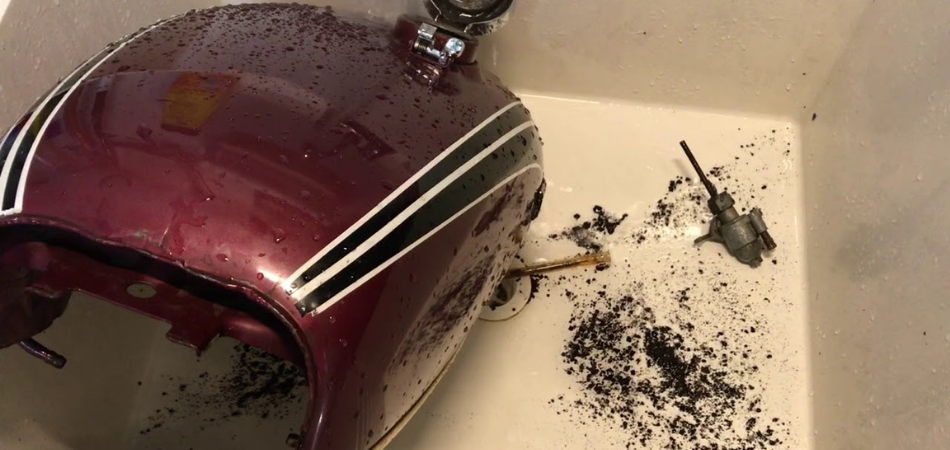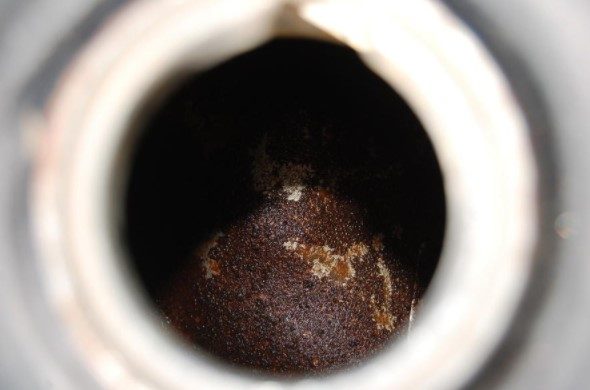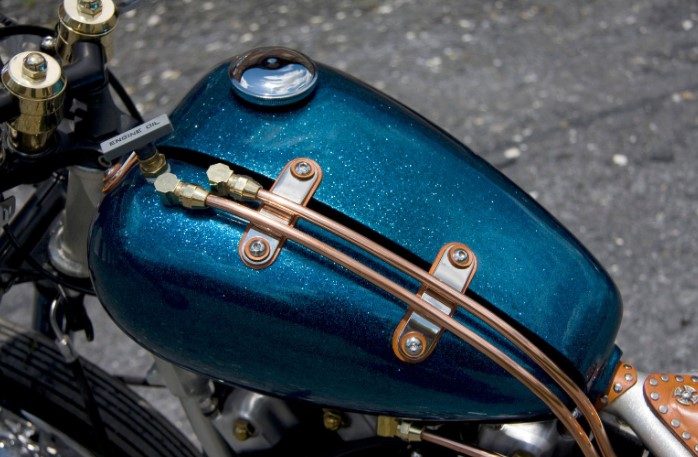A well-painted and shiny motorcycle indeed tells a lot about the rider. The motorcycle tank happens to be one of the most prominent features and, if not well taken care of, can ruin the bike’s outlook.
Many restoration projects can cease abruptly when the motorcycle tank is full of rust. It is also near impossible to find a gas tank replacement, which is why every serious rider must know how to remove rust from motorcycle gas tanks using vinegar.
One of the safest ways to remove chemical rust is mixing vinegar and baking soda. The combination will help to loosen the rust to muriatic acid or isopropyl alcohol which makes it easy for the rust to be removed.
It is dangerous to ride a motorcycle with a rusty gas tank, as rust can easily lead to holes and leaks. This article will educate readers on removing rust from motorcycle gas tanks efficiently.
Will Vinegar Remove Rust From The Gas Tank?
The procedure to Remove rust from motorcycle gas tank with vinegar is straightforward and, if done right, won’t take a lot of time.
People can use a simple home recipe like vinegar can be used to do away with rust in an effortless way. When objects are exposed to humidity and moisture or have been kept idle for a long time, vinegar can restore their viability.

With this recipe, rust can be cleaned from the inside of a gas tank because of its acetic acid. To do this, one should fill the gas tank with water and then drain it out. After fifteen (15) minutes, the tank should be rinsed with water until the water poured out of the tank is crystal clear.
Also, white vinegar can remove dust effectively from a tank because the rust reacts to the vinegar and gets dissolved. To achieve this, the bike owner should soak the rusty metal object inside white vinegar for some hours, after which only wiping can remove every dust particle.
Alternatively, one can dampen a cloth with white vinegar and use it to wipe the tank.
How To Remove Dust From Motorcycle Gas Tank With Vinegar?
Motorcyclists that want to remove dust from a gas tank safely should adhere to these safety measures:

- People should wear eye protection and a face mask to avoid inhaling gas fumes.
- People should work in an open area with enough air to prevent concentrated gases.
- One should avoid mixing products unless the producers give directions to do so; this will limit acidic reactions.
- It is essential to ensure that the sources of power and heat are far away when removing the gas tank.
- People should not forget to have the fuel drained out and kept adequately while work on the gas tank is ongoing
What Materials Do You Need To Remove Rust From Motorcycle Gas Tank?
After taking necessary measures, the next thing is to gather the supplies that will be needed. Tools such as;
- white vinegar
- bucket
- water
- towel
- gloves latex preferably
Steps To Removing Rust From Motorcycle Gas Tank
The steps involved in removing rust from a motorcycle gas tank are easy if the right tools and equipment are in hand. The following paragraph will approach the subject matter using a simple step-by-step guide.

Step 1: Get the Tank Ready for Cleaning
People should begin by removing the side covers from the motorcycle gas tank. This is usually the first step to removing any rust. It will help to access the tank on all sides. One does not need to go through much stress to remove the debris and dirt once the cover has been removed.
To do it effectively, one should use a wire stripper. However, it is worth mentioning that nothing except what is required for cleaning the gas tank should be removed. Without proper consideration, one might end up damaging other parts.
Step 2: Put the Tank in Vinegar
After the initial step, the next is to soak the tank in vinegar. One should ensure that the tank is full of distilled white vinegar.
One can then fill it to the brim and use a towel or cloth to seal it. It is vital to ensure every tank area is covered with vinegar, mainly where rust is evident. The tank is then allowed to remain in the vinegar for about twelve hours.
Step 3: Use Steel Wool to Remove Rust
The third step is to ensure the 12-hour duration expires. After 12 hours, the tank should be taken out of the vinegar and scrubbed to get the rust away using a piece of steel wool.
The wool is efficient enough to scrape any corrosion and loose rust from the tank’s surface. The tank should be scrubbed gently so as not to damage the metal.
Step 4: Soak One More Time
The tank should be soaked again after the initial one. This is after removing all the corrosion and rust using a ball of steel wool.
One should ensure that the tank is full of distilled white vinegar, and a piece of cloth or vinegar should be used to seal it. A period of six-hour should elapse before the tank is removed. This will allow the vinegar to work effectively.
Step 5: Use Paint Scraper to Remove Rust
It is crucial to keep an eye on the clock. Once the six hours expire, the tank should get taken out of the vinegar.
Then a paint scraper can be employed to scrape away the rust. If any corrosion remains on the tank’s surface, the scraper will help eliminate it.
To prevent them from posing a threat to people and the environment, it is vital to remove dirt and rust particles.
Step 6: Clean and Dry the Tank
After removing rust from the tank, the next step is to clean and dry it. This should be done with the utmost attention.
The tank should get filled with distilled white vinegar. Once complete, one can use a spare towel to seal it. This ensures that there is no trace of vinegar in the tank anymore.
Two hours should be given after cleaning. The tank’s content should get emptied before sealing it back with the side covers or other materials used initially, pour fresh gasoline in it.
Is Cleaning A Gas Tank Better Than Replacing?
Cleaning is not better than replacing the tank. It might be easier and more economical, but all that relies on how dirty and rusty the tank is.
Once the tank is destroyed, dirty, and covered in rust beyond repair, replacing it might be the best bet. Nevertheless, if there is only a mild breakdown or dirt, the tank can be cleaned.

It is worth noting that destroyed motorbike tanks can become dangerous quickly because explosive gasoline circulates into the rider and ted elements.
It does not matter whether the damage results from a crash or an internal breakdown. In cases like this having the gas tank replaced immediately can prevent severe consequences.
If an individual decides on replacement, it is easy to remove through on-hand tools, but the techniques will be quite different between the older and modern bikes.
How to Remove And Replace Gas Tanks On Old Model Motorbikes?
- First Step: Loosen the rider’s seat bolts using an Allen twist or use the seat release device to remove the seat.
- Second Step: Take out the bolts from the gas tank’s base using a socket twist.
- Third Step: At this point, lift the gas rear tank, then pull the whole gas tank towards the motorbike’s rear until the tank is no longer mounting on the bike’s frame.
- Fourth step: The fuel line should be Pulled off the valve on the left side of the gas tank; after that, quickly put in the new gas tank in the reverse order of removal
How To Remove And Replace Gas Tanks On Modern Motorcycles
- Step one: Just like in the older model, also loosen the rider’s seat hooks using an Allen wrench or by using the seat release tool to remove the seat.
- Step Two: Keep the pair of hooks on the upper half of the gas tank, close to the handlebars, using the Allen wrench still.
- Step Three: Take away the pivot hook from the gas tank’s base using a socket wrench.
- Step Four: After that, Lift the gas tank a little bit and drag the fuel line away from the fuel valve.
- Step Five: The last step is to remove the gas tank from the motorcycle and insert the new gas tank via reverse order.
How Do You Keep A Motorcycle Gas Tank From Rusting?
When the gas tank of your motorbike is not kept away from rust it is at risk of the following:
- Unstable fuel flow: When fuel flow is uneven, the acceleration level of your bike gets affected.
- The filters and lines of fuel become blocked this can lead to pressure build-up.
- Rust can begin to Circulate inside the engine, when this occurs the quantity of air mixing with the fuel drops.
How To Prevent Motorcycle Tank From Rusting?
Those that wish to prevent their motorcycle tanks from rusting can take the simple steps described in the next paragraph
The First step is to have the fuel tank plugged with high-octane gas. This takes place in different forms:
A full tank gives room for vapor to form, and lower octane fuels comprise of higher levels of alcohol that enable rust by drawing water.
The second step is to add a fuel stabilizer when the tank is not in use. The fuel stabilizer will protect the gas from pulling apart during storage and op gas from piling up.
On the flip side, the tank should be eradicated if the motorcycle is kept for a long time. In such cases, the fuel should be drained out completely; then, let the tank be exposed to air for drying. Packets of silica used to absorb moisture should also be placed in the fuel tank; after doing that, let the tank be closed completes preventing any form of water from entering the tank.
Conclusion
The beauty and aesthetics of a motorcycle will diminish considerably if the gas tank has a lot of rust.
However, knowing How to remove rust from motorcycle gas tank with vinegar is not only essential to keep the bike looking beautiful but also to prevent gas leaks and a potential hazard.
Fortunately, with the simple steps, people will have no problem removing rust from their motorcycle gas tanks.
